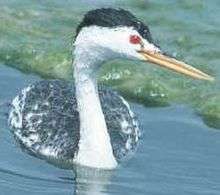List of birds of North America (other orders)
Loons

Order: Gaviiformes Family: Gaviidae
Loons are aquatic birds the size of a large duck, to which they are unrelated. Their plumage is largely gray or black, and they have spear-shaped bills. Loons swim well and fly adequately, but, because their legs are placed towards the rear of the body, are almost helpless on land.
- Arctic loon, Gavia arctica LC
- Common loon, Gavia immer LC
- Pacific loon, Gavia pacifica LC
- Red-throated loon, Gavia stellata LC
- Yellow-billed loon, Gavia adamsii NT
Grebes

Order: Podicipediformes Family: Podicipedidae
Grebes are small to medium-sized diving birds. They breed on fresh water, but often visit the sea when migrating and in winter. They have lobed toes and are excellent swimmers and divers; however, their feet are placed far back on their bodies, making them quite ungainly on land.
- Atitlan grebe, Podilymbus gigas (E) EX E
- Eared grebe, Podiceps nigricollis LC
- Clark's grebe, Aechmophorus clarkii LC
- Least grebe, Tachybaptus dominicus LC
- Pied-billed grebe, Podilymbus podiceps LC
- Red-necked grebe, Podiceps grisegena LC
- Horned grebe, Podiceps auritus LC
- Western grebe, Aechmophorus occidentalis LC
Flamingos
Order: Phoenicopteriformes Family: Phoenicopteridae
Flamingos (genus Phoenicopterus monotypic in family Phoenicopteridae) are gregarious wading birds, usually 3 to 5 feet (0.9 to 1.5 m) tall, found in both the Western and Eastern Hemispheres. Flamingos filter-feed on shellfish and algae. Their oddly-shaped beaks are specially adapted to separate mud and silt from the food they consume and, uniquely, are used upside-down.
- American flamingo, Phoenicopterus ruber LC
Penguins
Order: Sphenisciformes Family: Spheniscidae
- Galapagos penguin, Spheniscus mendiculus (A) EN E
Tropicbirds
Order: Phaethontiformes Family: Phaethontidae
Tropicbirds are slender white birds of tropical oceans, with exceptionally long central tail feathers. Their long wings have black markings, as does the head.
- Red-billed tropicbird, Phaethon aethereus LC
- Red-tailed tropicbird, Phaethon rubricauda LC
- White-tailed tropicbird, Phaethon lepturus LC
Storks

Order: Ciconiiformes Family: Ciconiidae
Storks are large, heavy, long-legged, long-necked wading birds with long stout bills and wide wingspans. They lack the powder down that other wading birds such as herons, spoonbills and ibises use to clean off fish slime. Storks lack a pharynx and are mute.
- Jabiru, Jabiru mycteria LC
- Wood stork, Mycteria americana LC E
- Maguari stork, Ciconia maguari (A)
New World vultures

Order: Cathartiformes Family: Cathartidae
The New World vultures are not closely related to Old World vultures, but superficially resemble them because of convergent evolution. Like the Old World vultures, they are scavengers. However, unlike Old World vultures, which find carcasses by sight, New World vultures have a good sense of smell with which they locate carcasses.
- Black vulture, Coragyps atratus LC
- California condor, Gymnogyps californianus CR E (and XN)
- King vulture, Sarcoramphus papa LC
- Lesser yellow-headed vulture, Cathartes burrovianus LC
- Turkey vulture, Cathartes aura LC
Sunbittern
Order: Eurypygiformes Family: Eurypygidae
- Sunbittern, Eurypyga helias LC
Trogons
Order: Trogoniformes Family: Trogonidae
Trogons are residents of tropical forests worldwide and have soft, often colorful, feathers with distinctive male and female plumage. They have compact bodies with long tails and short necks.
- Baird's trogon, Trogon bairdii NT
- Black-headed trogon, Trogon melanocephalus LC
- Black-tailed trogon, Trogon melanurus LC
- Black-throated trogon, Trogon rufus LC
- Citreoline trogon, Trogon citreolus LC
- Collared trogon, Trogon collaris LC
- Cuban trogon, Priotelus temnurus LC
- Eared quetzal, Euptilotis neoxenus NT
- Elegant trogon, Trogon elegans LC
- Gartered trogon, Trogon caligatus LC
- Golden-headed quetzal, Pharomachrus auriceps LC
- Hispaniolan trogon, Priotelus roseigaster NT
- Lattice-tailed trogon, Trogon clathratus LC
- Mountain trogon, Trogon mexicanus LC
- Orange-bellied trogon, Trogon aurantiiventris LC
- Resplendent quetzal, Pharomachrus mocinno NT E
- Slaty-tailed trogon, Trogon massena LC
- White-tailed trogon, Trogon chionurus LC
Hoopoes
Order: Upupiformes Family: Upupidae
This black, white and pink bird is quite unmistakable, especially in its erratic flight, which is like that of a giant butterfly. It is the only member of its family. The song is a trisyllabic oop-oop-oop, which gives rise to its English and scientific names.
- Eurasian hoopoe, Upupa epops (A) LC

